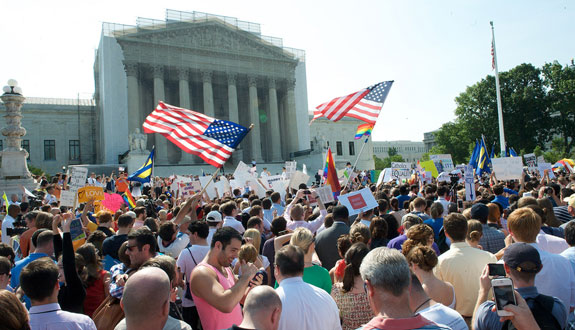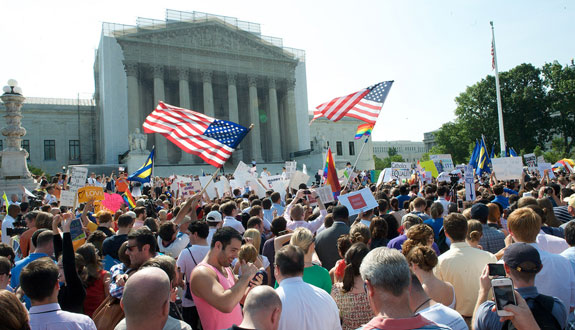Recapping the Supreme Court’s Banner Week
- by
- Jun 28, 2013
- News, Supreme Court Rulings
- Reviewed by: Matt Riley


It was a pretty big week for the Supreme Court. And, as they say, cases with far-reaching consequences make strange bedfellows. You’ve all read about the cases, but what really happened, and why was it important? Let’s look at Windsor/Perry, Shelby Co. v. Holder, and Perry v. Texas.
US v. Windsor/Hollingsworth v. Perry
In two decisions, the Supreme Court put forward what can only be considered a victory for marriage equality (even if Gov. Huckabee thinks it made Jesus weep).
In US v. Windsor, the majority used principles of federalism and the usual smattering of Amendments to strike down DOMA’s section 3 (unless you ask Scalia, who feels their entire argument was a bunch of hand-waving before just deciding whatever they wanted to decide). While a great step forward, it doesn’t allow couples from states that don’t allow same-sex marriage to avail themselves of similar benefits, as the Justices deferred to the states’ power to define marriage.
In Hollingsworth v. Perry, SCOTUS ruled that a bunch of Prop 8’s proponents lacked standing to challenge the finding that Prop 8 was unconstitutional. In a weird amalgamation of Justices (which is common when procedural issues such as standing play a deciding role), the Court ruled that California’s ballot system of governance doesn’t allow the proponents of a Proposition to have a special attachment to it after it is enacted into law. So if the state isn’t going to defend it, they can’t jump in.
Wins for the marriage equality movement? Of course. But the fight has just started, and neither ruling will stop discrimination. What they will do, however, is put the “traditional marriage” advocates on the defensive, and as all polls show, they’re on the wrong side of history.
Shelby Co. v. Holder
Wow. Did you read Ginsburg’s dissent? Her and Scalia seem like they’re fighting for the most scathing rebuttal to a majority’s argument.
In this ruling, the majority used some data about recent trends in voting numbers to overturn the historic legislation that called for pre-clearing of new voting standards in areas traditionally associated with voter discrimination. In light of their view that it isn’t a big problem anymore (their words, not mine), they ruled these sections of the Voting Rights Act to be unconstitutional.
Showing herself to be a former Blueprint LSAT Prep student (never mind that we didn’t exist when she was applying to law school, or even that the LSAT didn’t exist in its modern form), Justice Ginsburg said that maybe the Supreme Court is ignoring some pretty basic causation here — mainly that these areas are seeing decreased discrimination because of this law, and taking it away might lead to the effect disappearing as well.
Perry v. Texas
Spoiler Alert: Justice Thomas concurred in the judgment, but not with anything else.
A lot of people are saying the Supreme Court punted on the issue. I disagree. While I loves me some judicial activism, just like any good liberal, I also appreciate judicial restraint when the issue is complex and any decision is going to have a large effect on something as important as our education system.
The Court remanded the case because they felt the lower courts didn’t apply strict scrutiny when evaluating the University’s argument. They deferred too much in their determination that the program was both a compelling interest and necessary to achieve that interest, according to the majority. So they have to get through that determination.
As I said above, Thomas concurred with the opinion while dissenting with most of their argument (he has a stack of dissents ready to go for affirmative action cases). However, you have to agree, he makes a compelling argument. After all, if it’s settled law that the continued existence of a public school isn’t a compelling state interest, it’s hard to argue that diversity in that school is a compelling state interest.
What effect will this ruling have on law schools? Very little, yet. While it seems some courts were incorrectly interpreting earlier decisions of SCOTUS on the implementation of affirmative action programs, the schools believe themselves to have created programs that align with earlier decisions. Until a new case comes along where the Supreme Court takes an actual stance (and overturns some earlier decisions, if Thomas has his way), expect little change.
Up next for the Supreme Court?
Check out Lozano v. Alvarez, an international custody dispute that was just granted cert. For anyone who has taken my class, read the list of counsel to see why I bring it up.
Search the Blog

Free LSAT Practice Account
Sign up for a free Blueprint LSAT account and get access to a free trial of the Self-Paced Course and a free practice LSAT with a detailed score report, mind-blowing analytics, and explanatory videos.
Learn More
Popular Posts
-
logic games Game Over: LSAC Says Farewell to Logic Games
-
General LSAT Advice How to Get a 180 on the LSAT
-
Entertainment Revisiting Elle's LSAT Journey from Legally Blonde








